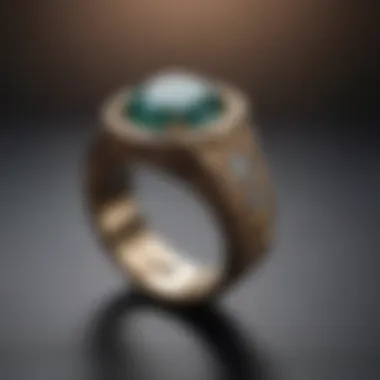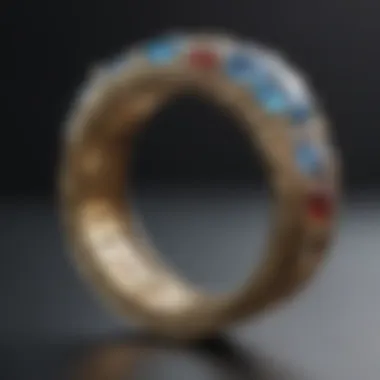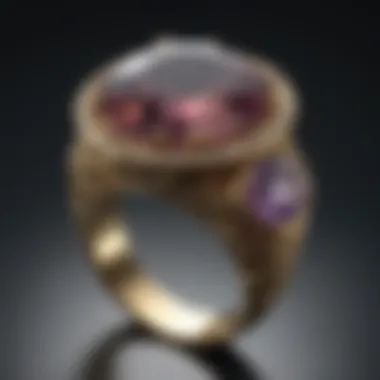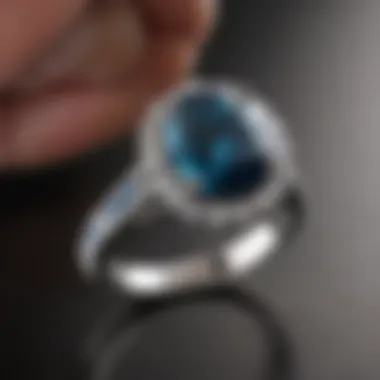An In-Depth Guide to Measuring Ring Size


Intro
Measuring ring size is crucial for anyone engaged in jewelry design or purchasing. An accurate ring size ensures comfort and satisfaction, minimizing the risk of resizing issues. This guide aims to equip both gemstone enthusiasts and jewelry designers with the necessary tools, techniques, and knowledge for precise measurement. By avoiding common pitfalls, readers will enhance their understanding and experience in the jewelry industry.
Overview of Measuring Ring Size
To effectively measure ring size, one must consider several factors, from the tools used to the specific measurement techniques. Understanding the various methods lays a strong foundation for achieving relevant results.
Importance of Correct Sizing
Correct ring sizing can affect both aesthetics and wearability. A ring that fits poorly may be uncomfortable or prone to damage. On the other hand, a well-fitted ring enhances the overall look and ensures durability. Therefore, measuring accurately becomes paramount.
Tools and Techniques for Measuring
A variety of tools are available for measuring ring size. Below are some commonly used options:
- Ring Sizer Tool: This is a set of graduated rings or a plastic sizer available for purchase.
- Jeweler's Mandrel: A solid cylindrical tool on which rings can be sized.
- String / Paper Method: A basic method that utilizes flexible materials to measure circumference.
Each tool has its merits and can deliver precise results if used correctly.
Common Pitfalls in Ring Sizing
Several mistakes can undermine the ring sizing process. Understanding these pitfalls can save time and resources.
Measuring at the Wrong Time of Day
Finger size can fluctuate based on temperature. It is advisable to measure rings when the body is at a normal temperature, avoiding extremes that can lead to incorrect readings.
Incorrect Tools
Using unsuitable or uncalibrated measuring tools can produce misleading results. Always opt for tools specifically designed for ring sizing for greater accuracy.
Ignoring Lifestyle Factors
Individual lifestyle factors may affect finger size. Consideration of activities, climate, or health factors is essential.
Accurate measurements leverage satisfaction and reduce the chance of resizing, which can damage delicate settings.
Ending
Having a comprehensive understanding of how to measure ring size can significantly elevate the jewelry design and purchasing experience. With accurate techniques and careful attention to potential pitfalls, individuals can create or select rings that not only fit well but also reflect personal style.
For more information on jewelry design and gemstone care, you may refer to articles on Wikipedia, Britannica, and community discussions on Reddit.
Remember, the path to perfecting ring size is not merely about numbers; it encompasses comfort, style, and personal expression.
Prolusion to Ring Sizing
Understanding the nuances of ring sizing is a crucial element for anyone involved in jewelry design, purchasing, or collection. It is not merely a matter of measurement; it holds profound implications for aesthetics, comfort, and the overall experience of wearing jewelry. The significance of an accurately measured ring size cannot be overstated. When the size is correct, a ring not only looks beautiful but sits comfortably on the finger, allowing for ease of movement. This guides individuals in selecting designs and settings that complement their fingers perfectly.
Several factors contribute to the importance of accurate ring size. For jewelers and designers, getting the size right ensures satisfaction among clients. When a ring fits well, it enhances the appreciation of the craftsmanship involved. Furthermore, improperly sized rings can lead to discomfort or even loss, leading to negative experiences that can tarnish one’s perception of quality jewelry.
Importance of Accurate Ring Size
Accurate ring sizing is vital across various contexts – whether one is crafting a bespoke piece or purchasing a mass-produced ring. A well-fitted ring secures itself on the finger while still allowing for adjustments in daily activities. Many people tend to underappreciate this aspect, often selecting sizes based on guesswork or inadequate methods.
A fitting ring contributes positively to the wearer's experience, minimizing the risk of slippage or pinching. Moreover, with gemstones, the weight and structure of the stone can influence the overall fit of the ring. If the stone is heavier, a snug fit might be required for longevity, particularly in daily wear situations. It is not uncommon for a misjudgment in sizing to lead to costly replacements and alterations.
Common Mistakes in Ring Measuring


When measuring for ring sizes, various pitfalls often lead to inaccuracies. One mistake includes not accounting for the finger’s temperature at measurement time. The fingers can swell due to heat and contract in cold temperatures, leading to faulty conclusions about the size needed. This means one should measure fingers under typical conditions when the body is at rest.
Another frequent error pertains to relying on subjective judgment about sizing. For instance, individuals might assume their ring size from past experiences or use tools that lack precision. Furthermore, many use inadequate tools like simple strings or flexible materials without accurate measurement markers, which leads to further inaccuracies.
"Taking the time to understand proper measuring techniques can ultimately save money and emotional stress in the long run."
Finally, an over-reliance on standard size assumptions can lead to setbacks. Just because someone typically wears a specific size doesn’t mean their measurements haven’t changed over time. This could be due to lifestyle changes, age, or even weight fluctuations. A practical consideration involves re-measuring regularly and ensuring one has the right equipment to achieve an accurate size.
Understanding Ring Size Systems
When it comes to choosing the right ring size, understanding the various systems used globally is crucial. Different regions have distinct methods to measure and denote ring sizes. Not grasping these differences can lead to immense frustration, whether you are purchasing a ring for yourself or designing one for someone else. Each system has its own specifications, which can affect the outcome of your selection process. By familiarizing yourself with these systems, you set the foundation for making informed decisions that enhance your overall jewelry experience.
ISO Standard for Ring Sizes
The International Organization for Standardization (ISO) has developed standardized ring sizes to facilitate global trade and ensure consistency in measurements. The ISO standard typically uses a numerical system ranging from 41 to 76, which refers to the inner circumference of the ring in millimeters. This system provides a universal reference point, eliminating confusion when shopping or designing rings across different countries.
One advantage of the ISO standard is its accuracy, as it aligns with precise measurements and enables seamless communication between jewelers and customers. It is particularly beneficial for online purchases or custom orders, as discrepancies due to varying local measurements are minimized. However, the ISO standard is not as widely recognized as the US system, which can lead to misunderstandings if not taken into account.
US Ring Size System
The United States employs a unique ring sizing system that may differ dramatically from the ISO standard. US ring sizes are based on numeric values ranging from 1 to 16, with half-size increments available. This sizing methodology is based on the inner diameter of the ring measured in inches. The US system's simplicity makes it accessible, but it also comes with its own challenges.
For example, a US size 7 might not correspond to the same inner circumference as an ISO metric size. This mismatch could result in a ring that does not fit properly. Thus, it is essential for consumers to confirm their size across both systems, especially in an increasingly global market. In addition, keeping the US sizes in mind is important when communicating with jewelers, even outside the US.
Other International Systems
Beyond the ISO and US systems, several other countries have developed their own respective ring sizing methods. For instance, the United Kingdom utilizes an alphabetical system where letters represent sizes, with additional half sizes indicated by a number or a plus sign. Japan follows a more numerical approach, similar to the US system but based on the inner circumference in millimeters, sometimes causing further confusion.
Adapting to these diverse systems can be daunting for gemstone enthusiasts and jewelry designers alike. To navigate this intricate landscape successfully, consider the following strategies:
- Research International Sizes: Familiarize yourself with the specific sizing system of the region you are interested in.
- Utilize Conversion Charts: These can be invaluable for comparing sizes across different standards, ensuring you get the correct fit.
- Consult with Jewelers: Experienced jewelers are often well-versed in the international sizing systems and can serve as reliable sources of information.
Understanding the differences in ring size systems ultimately allows for a smoother purchasing and designing experience. Gaining insight into these systems helps avoid the potential pitfalls of miscommunication, ensuring a perfect fit for every ring.
Methods for Measuring Ring Size
Measuring ring size accurately is vital for both the enjoyment and functionality of wearing a ring. An improper size can lead to discomfort, loss of the ring, or even damage to the stone or setting. Consequently, understanding various methods available for measuring ring size becomes essential for both gem enthusiasts and jewelry designers alike. Each method offers distinct advantages and may be more suitable depending on the situation and individual preferences.
Using a Ring Sizer Tool
Ring sizer tools are specialized devices designed specifically for determining ring size. These tools come in various forms, but their primary function remains the same—providing precise measurements.
Types of Ring Sizers
The most common types of ring sizers include plastic, metal, and digital sizers. Each type has unique attributes:
- Plastic sizers are lightweight, portable, and easy to use. They are ideal for personal measurements and often come with a wide range of sizes.
- Metal sizers, on the other hand, are more durable and typically used in professional settings. Their robustness makes them reliable for precision measurements.
- Digital sizers provide advanced functionality, capturing size data electronically, and are especially useful for custom orders.
These sizers allow users to measure quickly and effectively, reducing the room for error in measurement.
How to Use a Ring Sizer
Using a ring sizer is generally straightforward.
- Select the suitable tool, ensuring that it matches the individual’s need for accuracy.
- Slip the finger through the ring sizer, ensuring a snug fit without excessive force.
- Observe the measurement mark on the tool to determine the size.
This direct method leaves little room for mistakes, enhancing the reliability of the sizing process. However, it is crucial to check the fit at different times of the day, as finger size can fluctuate.
Measuring with a String or Paper Strip
This method is one of the most accessible and commonly used techniques for measuring ring size at home. A simple string or paper strip can provide a quick estimation of size.


Steps for Accurate Measurement
- Cut a strip of paper or string approximately six inches long.
- Wrap it around the base of the finger, ensuring it fits snugly but not too tightly.
- Mark the point on the strip where it overlaps.
- Measure the length of the strip up to the marked point in millimeters.
This method is practical and effective when done carefully, ensuring a reliable measurement.
Determining Size from Length
To find out the ring size from the measured string or paper length, one needs to refer to a standard chart that correlates the lengths to specific ring sizes. This method is especially useful because it can be done with items readily available in one's home. However, it's important to note that varying thicknesses of the string could result in different measurements, leading to inaccuracies.
Using an Existing Ring for Sizing
An existing ring can serve as a perfect reference for sizing, provided that it is worn on the same finger you intend to size.
Selecting the Right Ring
Choose a ring that fits comfortably on the finger for which you want to measure. Ensure it's the proper style, avoiding rings with larger or bulkier settings which may alter the fit. This method is popular due to its simplicity and straightforward nature.
Measuring the Inner Diameter
Once the appropriate ring is selected, measuring the inner diameter is the next step. Use a caliper or a ruler to find the diameter in millimeters. This numerical value can then be matched to a ring size chart, allowing for precise sizing. The key benefit of this method is its accuracy, as it directly uses a known reference. However, one must ensure that the selected ring has not been distorted or altered over time.
Considerations for Different Finger Types
Understanding the variations among different finger types is essential in achieving a perfect ring fit. Fingers vary widely in shape and size, and they can also change over time for several reasons. This section examines key aspects to consider when measuring ring sizes for different finger types, ensuring that the final piece complements both the wearer’s comfort and style.
Measuring for Wider Rings
When it comes to wider rings, such as those designed with a broader band, the sizing may require adjustment. Wider bands cover more surface area on the finger. Consequently, they can make the ring feel tighter than a narrower band of the same size. It is crucial to account for this difference when selecting a size.
One strategy is to go up half a size or more depending on the width of the band. Here’s what to consider:
- Width of the Ring: A ring that is 6mm wide usually requires a larger size than one that is 3mm wide.
- Comfort Fit: A comfort-fit design, which has a rounded inner surface, can mitigate size issues for wider rings.
Adjusting for Swollen Fingers
Fingers can swell for various reasons, including heat, dietary choices, and physical exertion. A ring that fits perfectly in the morning may feel constricted by the afternoon. When measuring for rings, it is critical to take potential swelling into account.
To address this, it is advisable to measure at the end of the day when fingers are generally the largest. Here are a few tips:
- Check Temperature: Avoid measuring your fingers in extreme heat or cold, as this can affect size.
- Flexible Measurement: Being aware of your lifestyle and how it may influence finger size can promote better fitting.
Seasonal Adjustments in Size
Fingers can also fluctuate in size according to the seasons. Typically, people experience swelling during warm weather and may find their fingers appear slimmer in colder months. This variation means that a ring size may not be consistent year-round.
To accommodate these seasonal changes:
- Spring and Summer: Consider a slightly larger size during warmer periods, as fingers tend to swell.
- Autumn and Winter: A snugger fit may be appropriate for these cooler months.
Proper measurement can prevent discomfort and ensure the ring remains a joy to wear no matter the time of year.
In summary, taking into account these considerations allows for a more tailored approach to ring sizing, accommodating the unique needs of various finger types and conditions. This proactive attention significantly enhances the overall experience of wearing jewelry.
By recognizing these factors, gem enthusiasts and jewelry designers can work towards delivering a more satisfying and tailored fit for their clientele.
Ring Size and Lifestyle Considerations
Understanding ring size goes beyond mere numbers; it is essential to consider the lifestyle of the wearer. Lifestyle influences how a ring fits and feels on the finger. Different activities demand different comfort levels, making it crucial to assess each aspect with diligence.


The first consideration is the daily activity of the individual. Those who engage in physical labor may need a slightly larger ring size to accommodate finger swelling and movement. In contrast, individuals in less active jobs might prefer a tighter fit. Wearing a ring that increases comfort and security during specific activities is paramount.
Additionally, certain hobbies or professions can expose the ring to conditions that might affect its fit. For example, athletes involved in sports might need rings that can withstand rough use. Selecting the appropriate size and style preserves the integrity of the jewelry.
Seasonal changes can also impact ring sizing. In warmer months, fingers tend to swell, sometimes requiring a larger size. Conversely, in colder weather, fingers can constrict, leading to a tighter fit. Understanding these variations can help in choosing the right size, ensuring an optimal balance between aesthetics and comfort.
In summary, assessing one’s lifestyle is crucial when determining ring size. It ensures the jewelry fits comfortably while still being stylish.
Choosing Sizes for Specific Activities
When selecting a ring size, certain activities should be prioritized. For instance, people who exercise frequently may benefit from a slightly larger size to allow for finger expansion during workouts. Here are some considerations based on activity:
- Manual Work: A size that allows for some movement can prevent discomfort during labor-intensive tasks.
- Athletics: Consider rings designed with specific features that enhance durability and fit during sports.
- Everyday Wear: A snug fit may be ideal for less active moments, while a looser fit is more practical when engaging in rigorous activity.
It is wise to design or select rings that accommodate these variances. Custom designs may also be considered for unique requirements.
Professional Recommendations for Jewelers
Jewelers play a critical role in guiding clients with their ring size decisions. Their expertise can help clients avoid potential sizing errors and recommend suitable sizes based on individual lifestyle choices.
- Conduct Measurements: Jewelers often have precise measurement tools, ensuring accurate sizing. It’s recommended to consult with them, especially for custom pieces.
- Suggest Adjustable Options: Options like adjustable rings can also be beneficial for those unsure about size, allowing for some flexibility.
- Educate Clients: By providing insights on how lifestyle affects size selection, jewelers empower clients to make informed choices. This approach underscores their professionalism and expertise.
Ultimately, jewelers should prioritize client satisfaction through knowledge sharing and accurate measurement techniques. This improves the buying experience while fostering a lasting relationship.
Challenges in Ring Sizing
Accurately determining ring size is undoubtedly a critical aspect of the jewelry-making process. However, several challenges can complicate this task. Understanding these challenges helps in identifying the correct size and ensuring customer satisfaction. This section highlights two main areas of concern: cultural variations in ring sizes and the barriers often encountered when ordering custom rings.
Cultural Variations in Ring Sizes
Cultural norms heavily influence the perception and measurement of ring sizes. Different countries use distinct sizing systems, leading to discrepancies in how sizes are interpreted. For instance, the US follows a numerical system, while countries like Japan use an entirely different scale that includes letters. Other nations have their unique identifiers, which can create confusion for jewelers and customers alike.
When navigating international markets, it is crucial to be aware of these variances. A ring that fits perfectly in one region may be too tight or loose in another. Moreover, cultural significance attached to ring designs and sizes can also affect purchasing decisions. For example, in some cultures, rings symbolize specific milestones, which changes the expectations around sizing and fitting.
Informing customers about these differences can help avoid misunderstandings. Some jewelers provide conversion charts to translate sizes from one system to another. However, these tools are only as useful as the accuracy of the original measurements. Thus, educating clients about the importance of proper measurements related to their cultural framework is essential for an optimal experience.
Barriers in Custom Ring Orders
The process of ordering a custom ring introduces its own set of challenges. Customization often lacks standardization, leading to complications in determining the correct size. Many customers may not realize that a one-size-fits-all approach to sizing is ineffective, especially for unique designs that may feature wider bands or intricate styles that change how a ring fits on the finger.
The barriers in custom ring orders can be categorized as follows:
- Communication Issues: Misunderstandings can arise between the jeweler and customer. Clear, detailed descriptions of what a customer envisions are vital to achieving an accurate size.
- Measurement Challenges: Customers may struggle to take accurate measurements on their own or may not have a convenient way to provide this information to the jeweler.
- Time Constraints: Custom orders can be time-consuming. If sizing issues are not addressed early, it may lead to delays in the production process, causing dissatisfaction among customers who expect timely deliveries.
"Ensuring that customers provide accurate sizes for custom rings is crucial. A small mistake in measurement can affect the entire design."
To overcome these barriers, an efficient communication strategy must be implemented. Jewelers can offer guided tutorials or personalized consultations to facilitate the process. This proactive approach helps in managing expectations and delivers a satisfactory experience.
Final Thoughts on Measuring Ring Size
Understanding how to accurately measure ring size is crucial for both jewelry makers and purchasers. The integrity of jewelry design greatly depends on appropriate sizing. A well-sized ring ensures comfort and wearability. Moreover, it reflects the craftsmanship and intention behind its creation. As explored in this article, there are various methods available for measuring ring sizes. The insights provided herein aim to make the ring selection process less daunting.
For jewelry designers, precise measurements can lead to client satisfaction and repeat business. Incorrect sizing can result in dissatisfaction, returns, and a negative impact on reputation. Notably, many people underestimate how ring size variations can significantly affect comfort in daily wear. Presenting rings with the wrong size can also affect the visual appeal. Therefore, it is an utmost priority to understand the nuances of ring sizing.
"Accurate ring sizing is not just a matter of convenience; it can be the difference between a cherished piece and a regretted purchase."
Summary of Key Points
- Accurate ring size is essential for comfort and visual appeal.
- Jewelry designers benefit from proper sizing through customer satisfaction.
- Common mistakes in measurement can lead to issues and dissatisfaction.
Resources for Further Learning
For those interested in delving deeper into the topic of ring sizing, consider exploring the following resources:
- Wikipedia
- Britannica
- Engage with communities on platforms like Reddit to share experiences and insights.
- Follow discussions and learn more insights on Facebook groups dedicated to jewelry making and design.
These resources can provide further context and techniques regarding the nuances of measuring ring sizes and the importance of correct fitting in jewelry.







